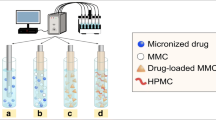Abstract
The purpose of this study was to examine doxorubicin adsorption in polypropylene containers as a function of pH and drug concentration based on anecdotal evidence of such adsorption. Doxorubicin loss was first examined in high-performance liquid chromatography (HPLC) glass inserts by UV absorbance to determine appropriate pH and time durations for subsequent analysis. Doxorubicin loss was then investigated in polypropylene microcentrifuge tubes at different pH values and starting drug concentration at 37°C over 48 h using HPLC with fluorescent detection. Doxorubicin concentrations was essentially constant in HPLC glass inserts at pH 4.8 up to 12 h but declined 5% at pH 7.4 by 3 h. The percent doxorubicin adsorption was calculated in polypropylene microcentrifuge tubes from extrapolations to zero time and was the least at pH 4.8, but increased with pH values 6.5 and 7.4, and decreased with drug concentration to reach a maximum adsorption of 45% in 2.0 μg/mL at pH 7.4 and 37°C. Degradation rate constants, ranging from 0.0021 to 0.019 h−1, also increased with pH in these studies. Determinations of low amounts of doxorubicin in polypropylene containers at pH 7.4 may be underestimated if adsorption and degradation issues are not taken into account.


Similar content being viewed by others
References
Chabner BA, Bertino J, Cleary J, Ortiz T, Lane A, Supko J, et al. Cytotoxic agents. In: Brunton LL, Chabner BA, Knollman BC, editors. Goodman and Gilman’s the pharmacological basis of therapeutics. 12th ed. New York: McGraw-Hill; 2011.
Vigevani A, Williamson MJ. Doxorubicin. In: Florey K, editor. Analytical profiles of drug substances. New York: Academic; 1980. p. 245–72.
Janssen MJH, Crommelin DJA, Storm G, Hulshoff A. Doxorubicin decomposition on storage. Effect of pH, type of buffer and liposome encapsulation. Int J Pharm. 1985;23(1):1–11.
Beijnen JH, van der Houwen OAGJ, Underberg WJM. Aspects of the degradation kinetics of doxorubicin in aqueous solution. Int J Pharm. 1986;32:123–31.
Wood MJ, Irwin WJ, Scott DK. Photodegradation of doxorubicin, daunorubicin and epirubicin measured by high-performance liquid chromatography. J Clin Pharm Ther. 1990;15(4):291–300. Epub 1990/08/01.
Wood MJ, Irwin WJ, Scott DK. Stability of doxorubicin, daunorubicin and epirubicin in plastic syringes and minibags. J Clin Pharm Ther. 1990;15(4):279–89. Epub 1990/08/01.
Tomlinson E, Malspeis L. Concomitant adsorption and stability of some anthracycline antibiotics. J Pharm Sci. 1982;71(10):1121–5. Epub 1982/10/01.
Bapat NV. Formulation and pharmacokinetics of doxorubicin associated with polymeric nanoparticles and oxidized dextran. PhD Dissertation, Northeastern University; 1991.
Van Hensbergen Y, Broxterman HJ, Elderkamp YW, Lankelma J, Beers JCC, Heijin M, et al. A doxorubicin-CNGRC-peptide conjugate with prodrug properties. Biochem Pharmacol. 2002;63:897–908.
Vora J, Bapat NV, Boroujerdi M. Investigation of the relative affinity of doxorubicin for neutral and negatively charge particulate carriers. Drug Dev Ind Pharm. 1993;19(7):759–71.
Wang Y, Yang ST, Wang Y, Liu Y, Wang W. Adsorption and desorption of doxorubicin on oxidized carbon nanotubes. Colloids Surf B Biointerfaces. 2012;97:62–9.
Miao J, Zhang F, Takieddin M, Mousa S, Linhardrt RJ. Adsorption of doxorubicin on poly(methyl methacrulate)-chitosan-heparin-coated activated carbon beads. Langmuir. 2012;28:4396–403.
Zutshi A. Physicochemical characterization and stability of doxorubicin in aqueous solutions. Ph.D. Dissertation, University of Florida; 1994.
Acknowledgments
The authors wish to thank Bristol-Myers Squibb for donation of doxorubicin and Steven Neau, Ph.D, at University of the Sciences in Philadelphia, for helpful discussions. Financial support was received for this investigation from NIH R15CA135421.
Author information
Authors and Affiliations
Corresponding author
Rights and permissions
About this article
Cite this article
Wu, D.C., Ofner, C.M. Adsorption and Degradation of Doxorubicin from Aqueous Solution in Polypropylene Containers. AAPS PharmSciTech 14, 74–77 (2013). https://doi.org/10.1208/s12249-012-9885-1
Received:
Accepted:
Published:
Issue Date:
DOI: https://doi.org/10.1208/s12249-012-9885-1




